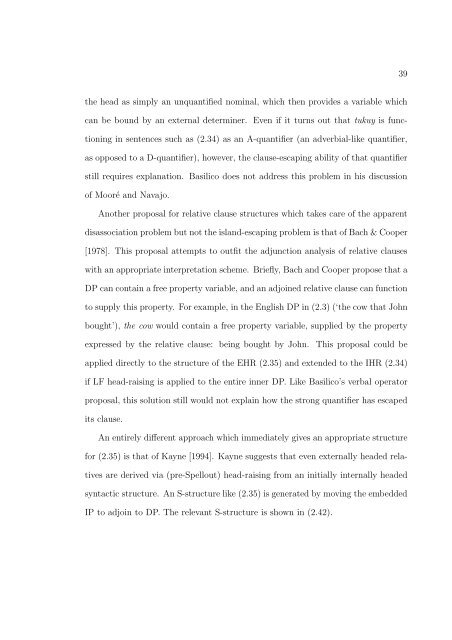the syntax and semantics of relativization and quantification
the syntax and semantics of relativization and quantification
the syntax and semantics of relativization and quantification
Create successful ePaper yourself
Turn your PDF publications into a flip-book with our unique Google optimized e-Paper software.
39<br />
<strong>the</strong> head as simply an unquantified nominal, which <strong>the</strong>n provides a variable which<br />
can be bound by an external determiner. Even if it turns out that tukuy is functioning<br />
in sentences such as (2.34) as an A-quantifier (an adverbial-like quantifier,<br />
as opposed to a D-quantifier), however, <strong>the</strong> clause-escaping ability <strong>of</strong> that quantifier<br />
still requires explanation. Basilico does not address this problem in his discussion<br />
<strong>of</strong> Mooré <strong>and</strong> Navajo.<br />
Ano<strong>the</strong>r proposal for relative clause structures which takes care <strong>of</strong> <strong>the</strong> apparent<br />
disassociation problem but not <strong>the</strong> isl<strong>and</strong>-escaping problem is that <strong>of</strong> Bach & Cooper<br />
[1978]. This proposal attempts to outfit <strong>the</strong> adjunction analysis <strong>of</strong> relative clauses<br />
with an appropriate interpretation scheme. Briefly, Bach <strong>and</strong> Cooper propose that a<br />
DP can contain a free property variable, <strong>and</strong> an adjoined relative clause can function<br />
to supply this property. For example, in <strong>the</strong> English DP in (2.3) (‘<strong>the</strong> cow that John<br />
bought’), <strong>the</strong> cow would contain a free property variable, supplied by <strong>the</strong> property<br />
expressed by <strong>the</strong> relative clause: being bought by John. This proposal could be<br />
applied directly to <strong>the</strong> structure <strong>of</strong> <strong>the</strong> EHR (2.35) <strong>and</strong> extended to <strong>the</strong> IHR (2.34)<br />
if LF head-raising is applied to <strong>the</strong> entire inner DP. Like Basilico’s verbal operator<br />
proposal, this solution still would not explain how <strong>the</strong> strong quantifier has escaped<br />
its clause.<br />
An entirely different approach which immediately gives an appropriate structure<br />
for (2.35) is that <strong>of</strong> Kayne [1994]. Kayne suggests that even externally headed relatives<br />
are derived via (pre-Spellout) head-raising from an initially internally headed<br />
syntactic structure. An S-structure like (2.35) is generated by moving <strong>the</strong> embedded<br />
IP to adjoin to DP. The relevant S-structure is shown in (2.42).
















